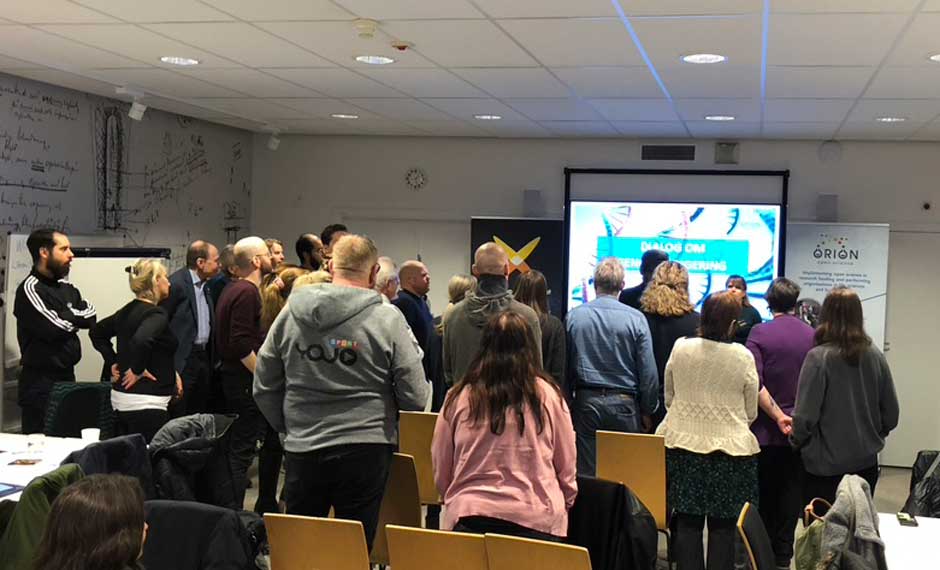What does the public think about the new genome editing technology and how should we talk about it? In Sweden and three other European countries, the EU project ORION Open Science has organised eight citizen dialogues to find out. Here we report on the two Swedish citizen dialogues held during January and February in Stockholm.

It was a dark January evening when around 30 specially selected participants from the greater Stockholm region met for the first time at the Swedish National Museum of Science and Technology in Stockholm. They met to talk about CRISPR, the genetic scissors that are used for genome editing. There were also two researchers from the Karolinska Institute, Fredrik Wermeling and Fredrik Lanner, as well as Lotta Eriksson, who represents the Swedish Medical and Ethical Council, SMER. They were all invited by VA (Public & Science) to discuss what major concerns and possible opportunities they see with the new genome editing technology, as well as how researchers and the ORION project should communicate about it with the public.
In addition to basic information about DNA, cells, genes and genomes, participants also initially learned more about CRISPR – often called genetic scissors. CRISPR technology makes it possible to very accurately ”cut” a small section of a gene to get rid of a particular disease, as well as ”paste” genetic sequences to introduce a desired trait.
After brief introductions by the researchers, most of the meeting was devoted to discussion. There were three tables, each with 10 members of the public involved in the discussion. Around each table was also a conversation leader, a scribe and a genome editing expert on hand to answer questions and explain concepts. The discussion revolved around various applications of genome editing, hopes and concerns about the techniques, possible future uses, ethical considerations and which communication channels work best.

…having been part of the project, I think it is a great idea to use artwork as a starting point for discussions with the public.
Participants could also take part in the art installation ÆON – Trajectories of Longevity and CRISPR, which was displayed at the Swedish National Museum of Science and Technology throughout January and February. In a series of photographs, artist Emilia Tikka, together with photographer Zuzanna Kaluzna, have portrayed a fictitious couple of lovers in which the man has chosen to take a medicine that keeps his body young, while the woman ages normally. In a picture where they stand close to each other, the man wears a protective mask.
Emilia Tikka got the idea for this imaginary future with anti-aging medicine after a stay at Max Delbrück Center for Molecular Medicine (MDC) in Berlin where she worked with genetics researchers for three months. In the laboratory, she learnt that it is actually possible to make individual cells live longer and to repair damaged cells with the help of genetic engineering.
Communicating cutting-edge research using art is relatively new and uncommon, but it helps to increase the breadth of communication. Creating new meeting points for researchers and the general public is also something that both the EU ORION project and VA (Public & Science) want to achieve.
“Initially, I was a bit skeptical of the idea of building the discussion around an art exhibition. It didn’t feel relevant. But having been part of the project, I think it is a great idea to use artwork as a starting point for discussions with the public,” said Fredrik Wermeling, a researcher at the Karolinska Institute.
The two events in Stockholm were part of a series of public dialogues organised during the autumn and winter of 2019-20 by the Babraham Institute in the UK, CEITEC in the Czech Republic and MDC in Germany. All are partners in the ORION project, which is investigating how research institutions and research funding bodies can become more open and incorporate more societal and end-user perspectives into their funding and research processes.
I am so grateful for this opportunity to learn more about the new gene technology and to talk to real researchers
Many of the participants in the citizen dialogues around the EU had little or no knowledge of genetic engineering. Most of them lacked experience in the scientific world and did not know anyone working in research. For many, it was also the first time they met researchers and participated in a public dialogue.
Gaining increased knowledge of a complex research area such as genome editing and CRISPR from prominent researchers was greatly appreciated. After the second dialogue in Stockholm, the attitudes of the participants to the research had also become more positive.
“I am so grateful for this opportunity to learn more about the new gene technology and to talk to real researchers,” said one of the participants at the second event in Stockholm.
IPSOS Mori in the UK is compiling the results of the public dialogues in the UK, Sweden, the Czech Republic and Germany and the report is expected to be completed during April. The results will inform how the ORION project partners interact with end users and patients, as well as how they communicate about genome editing and CRISPR in the future.
Want to know more about ORION?
VA (Public & Science) is one of nine European partners in the four-year Horizon 2020 ORION project, which is coordinated by the Center for Genomic Regulation in Spain and is ongoing until 2021. For more information about the project’s activities, contact project manager Maria Hagardt at VA.
